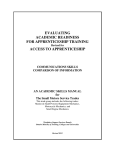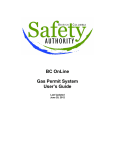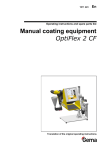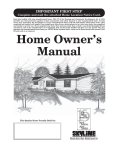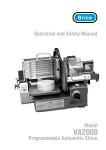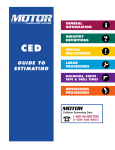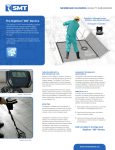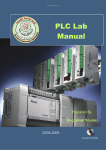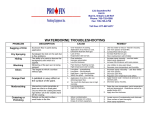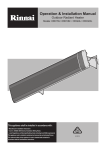Download Comparison & Contrast
Transcript
EVALUATING ACADEMIC READINESS FOR APPRENTICESHIP TRAINING Revised for ACCESS TO APPRENTICESHIP COMMUNICATIONS SKILLS COMPARISON OF INFORMATION AN ACADEMIC SKILLS MANUAL for The Auto Body Repair Trades This trade group includes the following trades: Auto Body &Collision Damage Repairer, and Automotive Painter Workplace Support Services Branch Ontario Ministry of Training, Colleges and Universities Revised 2011 In preparing these Academic Skills Manuals we have used passages, diagrams and questions similar to those an apprentice might find in a text, guide or trade manual. The information in them is not intended to instruct you in your trade. Trade related material is used only to demonstrate how understanding an academic skill will help you find and use the information you need. COMMUNICATIONS SKILLS COMPARISON OF INFORMATION An academic skill required for the study of the Auto Body Repair trades INTRODUCTION You make comparisons on the job every day. You compare saw blades when you pick one that cuts through metal over one designed to cut through wood. You compare techniques when you decide to use one type of welder instead of another. You compare long-term costs when you use a better grade of paint to finish a project because it is more durable than a less expensive grade. When you make a comparison, you examine two or more things to find out how they are similar and how they are different. While comparison examines both similarities and differences, contrasting only looks at differences. Once you have made your comparison or contrast of the different options available, you are in a position to evaluate what is the best choice for a given situation. In the auto body repair trade, you compare products and equipment for a variety of reasons: to decide which one is more durable, which is safer or which will work better in a specific situation. You learn to compare techniques and procedures through your reading, from listening to teachers, supervisors and skilled tradespeople, and through your experience on the job. In this skills manual, we will look at the following aspects of comparison: How comparison works Words that compares and contrasts Using text and graphics to compare Making choices PART I HOW COMPARISON WORKS From general to specific Most comparisons start with general information about a topic. This general information is your base or foundation. The topic could be power tools or welders. From this foundation you move to more specific topics such as drills or welding temperatures. Here you find definitions, descriptions and details about procedures and materials. As you read about a topic such as lubricants, you begin with an explanation, definition or description that applies to the large body of information about lubricants. Consider this as the base or foundation of information. Communication Skills for The Auto Body Repair Trades Comparison of Information Page 1 Access to Apprenticeship Workplace Support Services Branch, Ontario Ministry of Training, Colleges and Universities Revised 2011 As you read about types of lubricants, you learn how each type is different from and how each is similar to the other. Moving from the general to the specific gives you an overview of a topic. Next, you sort out the similarities and differences between: features of different types of lubricants recommended uses of each type You compare features, operation, procedures, conditions or costs related to the large group and to each item in the group. You can then compare the advantages or disadvantages of each. You are in a good position to choose the best method or product for a specific job. Passage 1 shows you this typical pattern. It starts with general information about lubricants. It then describes one type of lubricant – grease - and follows with a comparison of the different kinds of grease. Read Passage 1. As you read, pay attention to how using comparison leads you to understand the concepts. Passage 1 Lubricants Lubricants are substances such as oil, grease or graphite used on surfaces which slide or move against each other. Lubricants reduce friction and wear between components and increase their life. Properties of Grease Lubrication oils are thickened with a soap to produce greases. Adding thickener controls water resistance and thus resistance to machine breakdown that results from constant use and temperature range. The grease is also able to stay in place better. The content of soap in general purpose greases is usually from 7% to 18%; for special purpose greases the range can be from 3% up to 50%. Grease Types Simple Soap Greases combine a fatty acid with a base metal (calcium, sodium, aluminum, lithium or barium). Calcium soap: a small amount of water stabilizes this oil/soap structure. At temperatures of approximately 80C (175F), the soap and oil separate as the internal water works out. These greases are suitable for damp conditions but not for high temperatures. Sodium soap: Soluble in water. High temperature range. These soaps are recommended only for dry conditions and high operating temperatures. Aluminum soap: Used where adhesiveness is important because of stringy quality. Water-resistant; not recommended for high temperatures. Lithium and Barium soaps: The most commonly used soap greases; . . . Etc. Mixed Soap Greases combine various types of soaps to increase the service life of a grease. A mixture of calcium and sodium soaps offers water resistance . . . Etc. Communication Skills for The Auto Body Repair Trades Comparison of Information Page 2 Access to Apprenticeship Workplace Support Services Branch, Ontario Ministry of Training, Colleges and Universities Revised 2011 When you read Passage 1, it doesn’t say anywhere that types of greases will be compared but this is what is happening. We will look at Passage 1 in more detail to see how the comparison is organized. In paragraph one, you learn: what lubricants are: substances such as oil, grease or graphite; where they are used: on surfaces which slide or move against each other; and why they are used: [to] reduce friction and wear between components and increase their life. The answers to what, where, and why are the type of questions that you could answer from this description. This description applies to all lubricants. The next paragraph provides information about a specific type of lubricant – grease. The characteristics, advantages, and limitations of grease are described. The passage tells you: how machine grease is made; the effects of adding thickener (water resistance, stays in place, etc.); and the percentage of soap in two types of grease: general purpose greases, and special purpose greases. This description applies to all greases. This is how they are the same. For specific comparisons, you have to read on. Paragraphs three to eight provide details about simple soap greases. The similarities and differences in use and composition of different soap greases are compared. You are given information needed to decide which grease to use in different situations. By comparing and contrasting such things as composition and use, you can find out which item is suitable or recommended for a specific application. Using the information When you learn about materials such as lubricants, you get information and details that enable you to make comparisons. You could explain to someone else what to expect if you substituted one type of grease for another. Comparing greases can also show why an inappropriate choice, such as using sodium soap at low temperatures, could produce an unsuitable outcome, such as the grease thickening too much. When you learn about one thing, in this case, greases, you will probably go on to learn information about the features and use of other lubricants. Be prepared to think about their similarities and differences. Consider making your own list of advantages and disadvantages so you have a handy reference. Communication Skills for The Auto Body Repair Trades Comparison of Information Page 3 Access to Apprenticeship Workplace Support Services Branch, Ontario Ministry of Training, Colleges and Universities Revised 2011 Classification An important method of comparison is classification. Classification is a method of grouping things according to their similarities. Classifying materials, tools and techniques is a good way of keeping things organized. It also helps you see how things are related and how they differ. Read Passage 2 below to see how this works. Passage 2 Simple Machines A machine is a device that makes work easier by changing the speed, direction or amount of force. A simple machine magnifies the effects of an applied force. Levers Levers are the simplest of basic machines. The point where the lever pivots is the fulcrum of the lever. There are three classes of levers: Class 1: These levers have a fulcrum between the resistance force and the effort. Crowbars, bolt-cutters, jacks, pliers and scissors are all examples of Class 1 levers. Class 2: The resistance in these levers is between the fulcrum and the effort. If you lift an object by one end, it is a Class 2 lever. Wheelbarrows are an example. Class 3: The effort in these levers is applied between the fulcrum and the resistance. The effort arm is shorter than the resistance arm, and the effort is always greater than the resistant force. If you use your hand and arm to carry something, this is an example of a Class 3 lever. Cranes, back hoes and tweezers are examples. Passage 2 sets up comparison in a series of steps. Paragraph one starts with general information. It introduces the large classification, machines, and defines what a machine is. It then describes a more specific classification: simple machines. Then the passage focuses specifically on one type of simple machine – levers. You already know what a simple machine is or does. You can apply these facts to levers. You learn the definition of a lever. You also learn there are three classes of levers. Next, you get a definition for each of the three classes of levers. You can compare each of the three types of levers as to: • fulcrum points, • the relationship between resistance and effort, and You are also given examples of each class of lever By the end of Passage 2 you know how the different classes of levers are similar and how they different. You also know how each type is used. This description moves you gradually to a more detailed understanding. It is organized so that you build your knowledge gradually. Comparison through classification leads you to recognize the ways that something is similar to and different from others in its category. You can then use this information to generalize about how each will function in the workplace. Communication Skills for The Auto Body Repair Trades Comparison of Information Page 4 Access to Apprenticeship Workplace Support Services Branch, Ontario Ministry of Training, Colleges and Universities Revised 2011 Tables, charts and lists Tables, charts and lists are used to organize and compare information. The information is easy to use for comparisons because it is already organized into categories. You will find tables in manuals, texts and on-line. Tables cover a wide variety of material from metric and imperial measurement to categories of fasteners and gauges of material. You can use tables or lists to organize and compare information such as sheet gauges and weights, uses and strengths of different alloys, or possible solutions to problems with welded seams. For learning and studying purposes, you can convert information from a text into a list or table. After organizing material into a table, you can quickly recognize differences and similarities between products or techniques. You can also add information or columns to your list as you go. Read Passage 3, below, about testing electrical systems. Examine the table and see how it compares the hook-ups of different testing meters. Passage 3 Maintenance and Testing Electrical Systems The many different electrical systems require you to refer to the service manual for diagnosis and repair. Do a visual check when electrical problems occur. Because improper meter connections can damage the meter or circuit, carefully read the explanation of proper hookup that follows. Voltmeter connection: A voltmeter must be connected in parallel, not in series. It can be used to check voltage at any point in a circuit. Either a high or low reading may indicate circuit problems. Ammeter connection: An ammeter is always connected in series. Current must flow through both the circuit and ammeter. A higher or lower than normal current reading may indicate circuit problems. Ohmmeter connection: An ohmmeter can be connected in series or in parallel, but never to voltage or current. If connected to a live circuit, it could be damaged as it supplies its own power. When testing continuity of a wire, no resistance is wanted. When testing continuity in a coil, a certain amount of resistance is common. Compare tested resistance to the specifications in a service manual to determine circuit or component condition. Meters Hook up voltmeter in parallel ammeter in series ohmmeter in series or in parallel Communication Skills for The Auto Body Repair Trades Comparison of Information Page 5 Access to Apprenticeship Workplace Support Services Branch, Ontario Ministry of Training, Colleges and Universities Revised 2011 Table 1 below is a selection chart. Before you start, read the headings to see what features, functions or problems are compared. Also, read the footnote. Cover all the details. Look at how Table 1 is organized and what it compares. Answer the questions that follow. Answers are at the end of this skills manual. Table 1: COMPARISON OF FILLERS vs. PUTTIES Conventional Fillers Filler Composition Characteristics Application Heavyweight fillers Polyester resins and talc particles Smooth sanding: fine featheredging; non-sagging; less pinholing than lightweight fillers Dents, dings and gouges in metal panels Lightweight fillers Microsphere glass bubbles; fine grain talc; polyester resins Spreads easily; non-shrinking; homogenous; no settling Dings, dents and gouges in metal panels Premium fillers Microspheres; talc; polyester resins; special chemical additives Sands fast and easily; spreading is creamy and moist; spreads smoothly without pinholes; dries tack-free; will not sag Dings, dents and gouges in metal panels Note: The advantages and disadvantages of any filler are related directly to its application. Any decision about which is better should be made after considering every aspect of its intended use. Questions: 1. Which is not common to both lightweight and heavyweight fillers? a) polyester resins; used on dents, dings; used on metal panels b) talc particles; used on dents, dings; non-shrinking 2. Which of the following describes premium and heavyweight fillers? a) non-sagging; used on metal panels b) polyester resins; some pinholing c) used on dings; spreads easily 3. Which fillers have best spreading characteristics? a) heavyweight and lightweight b) lightweight and premium c) all about the same 4. Which filler would you choose to avoid pinholing on metal panels? a) heavyweight b) lightweight c) premium d) heavyweight or premium Communication Skills for The Auto Body Repair Trades Comparison of Information Page 6 Access to Apprenticeship Workplace Support Services Branch, Ontario Ministry of Training, Colleges and Universities Revised 2011 Know your purpose If your purpose is to understand the differences between fillers and putties, you can look across the rows and headings in Table 1 to compare them. Someone has compared these materials and then listed the information. The table is a comparison in brief, so you can quickly find information. Comparisons presented in a table do some of the work for you when you are selecting the most suitable tools, materials and processes. Look carefully to compare the characteristics, details and application. This enables you to make the best choice. Build from the base up Comparison comes in a variety of forms - some obvious and some not so obvious. However, the purpose remains the same: to give you a base and then to show you similarities and differences. PART II WORDS THAT COMPARE AND CONTRAST In Part II, we look at some of the words and phrases that you can use to recognize when something is being compared or contrasted. Remember, comparison means both similarities and differences while contrast means differences only. If someone says to you, "I drive the same car as you do," you immediately know a lot about their car. You take what you know about your own car and apply that information to their car. To compare them thoroughly though, you have to ask some questions. You might compare this type of detail: make, model and year, engine size, colour and condition, number of kilometres, Direct Comparison It’s nice when they tell you Some words and phrases immediately signal that a comparison or a contrast is to be made. When a comparison is signaled in this way it is called a direct comparison. Words such as same, like, similar, and all tell you about something and compare it to something else. And, note the different ways of saying all - whatever the type and regardless of the type. Examples: Another gauge similar to the tram type is the tracking gauge. Corrosion increases where snow and ice get trapped under the floor matting. Likewise, if water accumulates in clogged side sills and holes at the bottom of doors, it produces the same result. If you do not knead the hardener, it can result in the same problems as listed for poor filler mixing. Communication Skills for The Auto Body Repair Trades Comparison of Information Page 7 Access to Apprenticeship Workplace Support Services Branch, Ontario Ministry of Training, Colleges and Universities Revised 2011 Some comparisons show similarities, and then point out differences by using words such as some, many, most, different and unlike. For example, if some snips cut heavier gauge metals, it means that some others will not. Examples: Not all acrylic enamels are like this. Some have no critical re-coat period. Abrasive papers and discs are made of different shapes and sizes depending on their application. Unlike aluminum oxide, silicon carbide is a very sharp and fast-penetrating grain. Words and phrases such as while, except, unless, on the other hand, whereas, instead of, however set up comparison, but they point out contrasting or different uses, design or applications. Examples: Spot putty is the same as glazing putty except it has even more solids. Fillers will adhere, whereas putties are very weak and will not adhere to metal or filler. The similarities between some paints include the technique which is identical for application. Right-hand thread is understood, unless left-hand thread is specified in the diagram. The power supply for an electric drill is the electric cord, whereas in a pneumatic drill, it is the air hose. All threads do not take equal amounts of loading. The words relative or relatively mean compared to each other, or other items. Examples: Iron is relatively more active than copper. Some setups on sheet metal machinery are relatively simple. When comparing information, you might have to reread a few times to get all the details. Examples: These fires are put out by the same process as TYPE B, but the extinguishing material must be electrically non-conductive. Recommended spark plugs for all models except 36S2 and 8S3-1 pumps is XXXX. A DC generator works on the same principle as the alternator. Magnetism is used to induce current in the generator windings; however, a generator differs from a simple alternator in three ways. Some comparison/ contrast words and phrases restrict you, or tell you not to do something. Words like: only as stated: exclusively, excluded, and only, tell you something is allowed or permitted. Communication Skills for The Auto Body Repair Trades Comparison of Information Page 8 Access to Apprenticeship Workplace Support Services Branch, Ontario Ministry of Training, Colleges and Universities Revised 2011 Example: Some metals are excluded for this use because of corrosion. Watch also for these comparison words and suffixes: less . . . than Steel pipe is less flexible than aluminum. more . . . than A welded joint on flat metal will provide more strength than a soldered joint. as. . . as Arc welding will produce a weld as strong as an oxyacetylene weld ___er . . than Aviation snips can cut heavier gauge than the large bulldog snips. Duct tape is thicker than masking tape and provides more surface protection. The best way to cut rigid and flexible copper is with a tubing cutter. ___est Indirect Comparison When comparison is not stated In some cases, a comparison is not obvious. Example: Experienced technicians know the advantages of tools of high quality purchased from reputable manufacturers: Most do the following: offer lifetime guarantees against failure, are made from quality materials, hold up under use, and enable them to do better work. Although no comparison is stated here, turn the information around to discover the indirect comparison. The information suggests that the opposite is true about poor quality tools. While you might later find other opinions, you could conclude that many poor quality tools: do not offer lifetime guarantees against failure. Are not made from quality materials, do not hold up under use, do not enable installers to do better work. Watch for information that is not directly stated. You may have to pull out the details. Example: The disadvantage of open-end wrenches is that they only grip two faces of the nut. This rounds off the nuts and may cause injury to hands. Use comparison and contrast to gather information. If open-end wrenches have these disadvantages, another more suitable tool might be available. Select the proper product to avoid problems. Communication Skills for The Auto Body Repair Trades Comparison of Information Page 9 Access to Apprenticeship Workplace Support Services Branch, Ontario Ministry of Training, Colleges and Universities Revised 2011 Math language In math, the concepts of proportion, ratio, decimals and percentages are forms of comparison. Each of these terms is used to compare one amount or measurement to another. They are fundamental to mixing products, determining slope or finding safe bearing weights. They are also used to compare quality, strength of materials and cutting speeds. Examples: A ten-tooth gear will make three revolutions for each revolution of a thirty-tooth gear. The large gear will turn at 1/3 the speed of the small gear. Roller diameter is about 5/8 of the pitch. A general rule is to use a 1-inch bead of hardener for each golf ball-sized amount of filler. If the filler is as big as a baseball, use about a 6-inch bead of hardener. However, always refer to the manufacturer’s instructions for exact mixing proportions. The proportion is usually 10 percent hardener (that is one part hardener for each ten parts filler). PART III USING TEXT AND GRAPHICS TO COMPARE Text and graphics often work together to compare different aspects of a relationship. The text explains and gives examples while graphics list items or illustrate specific parts or procedures. When you use both sources of information, they work together to provide you with complete data on which to then base your comparison. Read Passage 4 and Table 3 below to compare the relative activities of metals. You also learn why this comparison is relevant to the metal trade. Use the text and the table to answer the questions that follow. Answers are at the end of this skills manual. Passage 4 Galvanic Corrosion When two dissimilar metals are in contact with each other, galvanic corrosion occurs. The metal that is more chemically active will corrode. See Table 2. For example, zinc will corrode, cover, and thus protect, steel. Communication Skills for The Auto Body Repair Trades Comparison of Information Page 10 Access to Apprenticeship Workplace Support Services Branch, Ontario Ministry of Training, Colleges and Universities TABLE 2: Revised 2011 Relative Activity of Metal Magnesium Aluminum Most Active ▲ Zinc Chromium Iron Cadmium Cobalt Nickel Tin Lead Copper ▼ Least Active With other metals, galvanic corrosion can cause problems. For example, the coatings on galvanized steel and tin plate are corrosion resistant. If the seams of these metals were welded, the welding process would burn off the protective coating. This would result in a product that fails. For wood-shingled roofs, only rust resistant nails are recommended. Hot-dipped, zinc-coated nails with the strength of steel and corrosion resistance of zinc are recommended. Questions: 1. According to Passage 4 and Table 2, aluminum is more chemically active than nickel. 2. T F If iron and nickel are in contact with each other, the nickel will corrode. T F 3. Galvanic corrosion may cause problems even when dissimilar metals are in the least chemically active range. T 4. F The following will prevent accelerated (faster) galvanic corrosion: a) using the least active metals b) using specialized (dielectric) fittings c) using two dissimilar metals Text and graphics work together When information is complex, using both text and graphics to compare and contrast helps you get the whole picture. Text and graphics – diagrams, tables, charts, illustrations, photos – work together to describe and illustrate what you need to know in order to make good choices. Communication Skills for The Auto Body Repair Trades Comparison of Information Page 11 Access to Apprenticeship Workplace Support Services Branch, Ontario Ministry of Training, Colleges and Universities Revised 2011 Read Passage 5. Note the language cues and patterns of comparing as you read the passage. Use the text and the table to answer the questions that follow. Answers are at the end of this skills manual. Passage 5 Hose Size The proper size and type of hose will deliver air from the compressor and material from its source to air tools and guns. When air is compressed, and travels a long distance, its pressure begins to drop. However, you can keep this pressure drop to a minimum (for a distance up to 100 feet) when you use proper fittings and a hose of the proper diameter. Table 4 shows hoses of different lengths (5 feet and 50 feet) and different internal diameters (1/4 inch up to 3/8 inch). You can compare the pressure drop at different pressures for these hoses. Compare PSIG for 5-foot lengths (column 2) and PSIG for 50-foot lengths (column 3). At low pressure and short lengths of hose, the drop is not significant. At higher pressure and longer lengths, the pressure drop becomes much greater. It must be compensated for. TABLE 3: AIR PRESSURE DROP ID stands for Inner Diameter PSIG stands for Pounds per Square Inch Gauge Size of Air Hose (ID)* 5-foot length 50-foot length 1/4 inch @ 40 PSIG 60 PSIG 80 PSIG PSIG ^ 0.4 4.5 5.5 PSIG 16.0 20.0 25.0 5/16 inch @ 40 PSIG 60 PSIG 80 PSIG PSIG 0.5 1.0 1.5 PSIG 4.0 6.0 8.0 Questions: 1. Low pressure and short lengths of hose may cause a significant drop in air pressure. T F 2. Higher pressure and longer lengths would result in approximately the same drop in air pressure as lower pressures and shorter lengths. T F 3. Which of the following would you compensate for? a) low pressure and short lengths of hose b) higher pressure and longer lengths of hose c) higher pressure and hose of proper diameter Communication Skills for The Auto Body Repair Trades Comparison of Information Page 12 Access to Apprenticeship Workplace Support Services Branch, Ontario Ministry of Training, Colleges and Universities Revised 2011 4. An inner diameter of 1/4" with a 60 PSIG will experience pressure drop of 4.5 at 5-foot lengths. T F By comparing what you read and what you see, you are using an important technical tool. When data is simple, you can get what you need from either written text or diagrams. When information is more complex, you usually need both. PART IV MAKING CHOICES To follow steps correctly, to double-check work or to understand a problem, you are constantly making comparisons. Think about how this works. To follow instructions, you have to compare what you are reading in a manual to what you are actually doing. Comparing what is shown in the text to the results in front of you will help you decide if you are on the right track The list below suggests questions you might ask when you are making a decision: What features do these products or methods have in common? How do they differ? Is one better in certain situations than the others? Why? How do costs compare? Which is the better choice for my situation? Why? Passage 6 compares and contrasts features of two types of wrench. Read the passage and answer the questions that follow. Answers are at the end of this skills manual. Passage 6 Wrenches Box-end wrenches have a closed end for better holding power. The jaws fit completely around a bolt or nut and grip each point on the fastener. The box-end wrench is thus the safest. More force can be applied without slipping and causing damage to the bolt or nut head. The 6-point wrench is the strongest because it surrounds completely the hex nut and brings force to bear on all six sides and points. The 12-point wrench also grips the six points but does not bear on the face surfaces of a hex nut; this means there is a greater potential for slippage. The advantage of a 12-point wrench is that the wrench can grab the nut in twelve different positions. In confined spaces, the additional engagement points increase the possible turning radius. The handle of a box-end wrench is often offset 10 to 60 degrees to reach down into an area without the handle hitting the part. Questions: 1. Which of the following describes advantages of box-end wrenches? a) closed end, offset handle, jaws fit completely around a nut b) more force can be applied without slipping, the box-end grips in twelve different positions c) both a) and b) Communication Skills for The Auto Body Repair Trades Comparison of Information Page 13 Access to Apprenticeship Workplace Support Services Branch, Ontario Ministry of Training, Colleges and Universities Revised 2011 2. In confined spaces, the 6-point wrench will give an increase in turning radius. T F 3. Both the 12-point and 6-point wrench have equal grip on a bolt or nut. T F 4. Which wrench would you choose for greatest strength? a) either 6 or 12-point b) 6-point c) 12-point A final point about how comparisons work. When you start with good basic knowledge about something, you can understand and evaluate the details that follow. You will be ready for each new idea as it is presented. When you know how a tool or fitting works, you can understand why it is designed the way it is. This foundation will also help you decide which tool or fitting to choose. Once you know how to select a power sprayer, you are on your way to learning how to paint. Textbooks, manuals and supervisors assume you understand basic information as you move through the course. If you are missing basic information, you may find you can’t make effective comparisons as new ideas are presented. Make sure your basics are sound before going on. And remember, a change in a routine or a product might affect the outcome. For example, you might always get 80% or more on tests. If you change the number of hours you study, or skip breakfast, your results may be different. If you compare such cause and effects over a period of time, you learn something about the relationship between behavior and outcome. This can lead you to think about how you make choices in your learning and your job. CONCLUSION Information in your texts is set up so you can create a base of knowledge. From your base, you can compare and contrast the different materials, tools and procedures that you have learned. When reading technical material, look for words that compare and contrast. They can alert you to comparisons. This enables you to make sound choices as to what is most suitable for each situation Charts and table provide easy ways to compare and contrast because the information is organized into categories Principles and measurements may not change but tools, applications, materials, equipment, conditions and seasons do. To adapt to change, compare the old with newer information. This will enable you to keep up to date in the metal trade and have happy employers and clients. Communication Skills for The Auto Body Repair Trades Comparison of Information Page 14 Access to Apprenticeship Workplace Support Services Branch, Ontario Ministry of Training, Colleges and Universities Revised 2011 Summary 1. Understand how comparisons work: • from the large topic to an item-by-item comparison • through classification • through tables and charts 2. Build from a solid base. If a comparison doesn’t make sense, stop and get help. 3. Look for patterns and language that compare and contrast. Watch for tables and passages that compare without telling you (indirect comparison). 4. Use text (written) and diagrams together to compare information. Use all details available. 5. Change in one area results in change to another area. Compare details to make the right adjustments to adapt to the change. 6. Compare what you read with what you do. It is an important technical reading tool. Communication Skills for The Auto Body Repair Trades Comparison of Information Page 15 Access to Apprenticeship Workplace Support Services Branch, Ontario Ministry of Training, Colleges and Universities Revised 2011 Answer page PART I Table 1, Fillers and Putties 1. Which is not common to both lightweight and heavyweight fillers? b) talc particles; used on dents, dings; non-shrinking A careful comparison of the descriptions of both lightweight and heavyweight fillers is needed. 2. Which of the following describes premium and heavyweight fillers? a) non-sagging; used on metal panels 3. Which fillers have best spreading characteristics? b) lightweight and premium 4. Which filler would you choose to avoid pinholing on metal panels? c) premium PART III Passage 4, Galvanic Corrosion and Table 2 1. According to Passage 5 and Table 4, aluminum is more chemically active than nickel. T Find each metal on Table 4 and compare its position to the other to determine which is least and most active. 2. If iron and nickel are in contact with each other, the nickel will corrode. F “Whichever of the two metals is more chemically active will corrode.” The more active metal in the table is iron. The nickel, therefore, would not corrode. 3. Galvanic corrosion may cause problems even when dissimilar metals are in the least chemically active area. T If dissimilar metals are in contact, problems can occur. This is why you are directed to use the same materials for fittings. PART III Passage 5, Hose Size and Air Pressure Drop 1. Low pressure and short lengths of hose may cause a significant drop in air pressure. F Although there is a relationship between the two, Paragraph 4 states that this combination would not cause a significant drop. Communication Skills for The Auto Body Repair Trades Comparison of Information Page 16 Access to Apprenticeship Workplace Support Services Branch, Ontario Ministry of Training, Colleges and Universities Revised 2011 2. Higher pressure and longer lengths would result in approximately the same drop in air pressure as lower pressures and shorter lengths. F You need to compare low pressure and short lengths to high pressure and long lengths. When you do this, you find the effects in air pressure are significantly different. 3. You would compensate for b) higher pressure and longer lengths of hose. Answer b) is clearly stated in paragraph four. 4. An inner diameter of 1/4" with a 60 PSIG will experience pressure drop of 4.5 at 5-foot lengths. T This question asks you to compare information in a table to find the right answer. PART IV Passage 6, Wrenches 1. Which of the following describes advantages of box-end wrenches? a) closed end, offset handle, jaws fit completely around a nut. 2. In confined spaces, the 6-point wrench will give an increase in turning radius. F It is stated that a 12-point wrench increases the turning radius. The passage doesn’t tell us about a 6-point. This is a question where you will need more information 3. Both the 12-point and 6-point wrench have equal grip on a bolt or nut. F Paragraph 2 states that the 6-point surrounds the hex nut. The next sentence states that the 12-point does not bear on face surfaces and has a “greater potential for slippage.” 4. Which wrench would you choose for greatest strength? b) 6-point. This is stated in paragraph two. Communication Skills for The Auto Body Repair Trades Comparison of Information Page 17



















